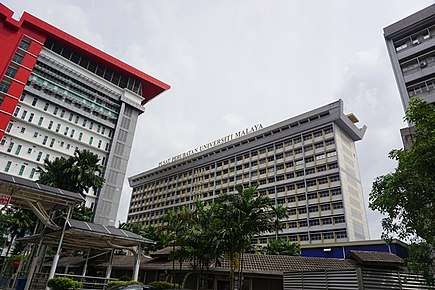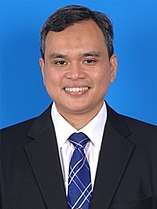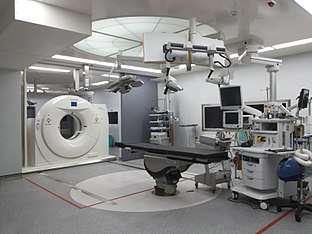University Malaya Medical Centre
University of Malaya Medical Centre (UMMC)[1] formerly known as University Hospital is a government-funded medical institution located in Pantai Dalam, southwest corner of Kuala Lumpur, the dynamic and bustling capital city of Malaysia. It was established by Statute in September 1962 and is part of University of Malaya.[2]

History
[3] Shortly after the end of the second World War, a commission was established under the Chairmanship of Sir Alexander Carr-Saunders to enquire into and make recommendations concerning university education in Malaya (Malaysia). The Commission arrived in March 1947, and after an intensive study recommended that the King Edward VII College of Medicine and Raffles College be almagated forthwith to form a University of Malaya. Accordingly, the University of Malaya was established in Singapore on 8 October 1949 as a national institution to serve the higher educational needs of the Federation of Malaya and of Singapore.
In 1957, a Commission of Enquiry was set up by the Governments of the Federation and of Singapore at the request of the University of Malaya to review the constitution, working and finances of the University in the light of the experience and rapid expansion of last seven years and of the prospective expansion in the near future, including the plan for developing the University in Kuala Lumpur, and to make recommendation. Arising from the Commission's Report and that of a Joint Constitutional Committee appointed by the two Governments, legislation was passed in November 1958 providing for the continuance of the University of Malaya as a single University, but with two largely autonomous divisions of equal status, one in each territory. This legislation came into effect in January 1958.
In 1960 the Government of the Federation of Malaya indicated that the Kuala Lumpur Division of the University of Malaya should become he national University in the Federation with effect from the beginning of the session 1962/63, and likewise the Singapore Government indicated that the Singapore Division should become the national University of Singapore. Steps to achieve the establishment of these two separate Universities were finalized during the year 1961 and the University of Malaya was established on 1 January 1962.
The University of Malaya is situated on a site of about 750 acres of land in Pantai Valley on the outskirts of Kuala Lumpur, a rapidly growing city of over half million inhabitants, the capital of Malaysia and near the geographical centre of the Peninsula. One outstanding feature of the University is its rapid growth and development.
The University Hospital, A Brief Introduction
Although the main hospital building was completed by December, 1966, commissioning of the Hospital and opening of the wards proceeded slowly mainly because of a shortage of nursing staff. The first patients were admitted in March 1967 and before the end of the year several wards had been opened together with the Polyclinic and Accident and Emergency Unit thus making available to the residents of Petaling Jaya and the adjoining area of Petaling Jaya and the adjoining area of Kuala Lumpur a hospital service on a 24-hour basis. By the end of 1969, all 758 beds were available for use. A new ward block of 112 bed was constructed in 1974 and commissioned providing for a total of 870 beds for the University Hospital.
Currently known as University of Malaya Medical Centre, it has 1,643 beds which is distributed by 44 wards throughout the medical centre serving a population of 1,782,375 for the district of Petaling.
Brief History of UMMC
The University of Malaya's (UM) medical faculty was the first school that was instituted at UM in 1905 following the Education Commission report that the colonial region in South East Asia needed to address the shortage of medical assistants in the large cities of Singapore and Penang. This was after the first unsuccessful initial attempt to establish a medical school to train assistant surgeons in 1889. Back then; when the country was under the rule of the British Empire, such a view that a European system of medical school is to established in a colony state was not particularly favored among the European community and therefore there were several obstacles to be overcome before the school could be established. However, despite the odds, in June 1905, under the Straits Legislative Council of Malaya, legislation of the establishment of a medical college in Singapore was passed under the Ordinance No. XV 1905. Following public appeal for funds, the school opened on July 3, 1905 but only started its courses in September the same year. On September 28th, 1905, Sir John Anderson officiated the school under the name "The Straits and Federal Malay States Government Medical School". With the division of the university into two autonomous campuses in Kuala Lumpur and Singapore in 1959, and the passing of the legislation in 1961 by both governments of Malaya and Singapore to make UM a national university, University of Malaya became permanently located in Kuala Lumpur as of January 1, 1962. With this came the new teaching and research facility and its own 500-bed hospital. The Singapore Division was renamed the University of Singapore.
The term "Medical Centre" was first used in 1963 to refer to "the whole Medical Centre complex composed of the departments of the Faculty of Medicine, the Teaching Hospital and the ancillary services attached to them". That was the definition used in the Hospital Act XXII of 1965, Statute XXVIII (The University Hospital) of 1967 and Statute XXXVI (The University Hospital) of 1971. It was also used in Statute XV New Series (The University Hospital) of 1977 which was amended by Statute XX (NewSeries) consequent to the 1975 amendments (A295) to the Universities and University Colleges Act (A30) [or "UUCA].
Although the Faculty of Medicine was established by Statute in 1962, planning, design and construction of the entire Medical Centre project only began actively from 1 February 1963 when Dr. T.J. Danaraj assumed duty as the first Professor of Medicine and the Foundation Dean of Medicine. The first batch of Pre-Medical students were admitted in May 1963 and were taught in the Faculty of Science. Teaching of the Pre-Clinical Year began for the first time in May 1964 in the Faculty of Medicine premises. The Faculty was officially opened on 2 August 1965 by YAB Tun Abdul Razak bin Dato Hussien, The Deputy Prime Minister, who also laid the Foundation Stone of the University Hospital on the same day. The University Hospital admitted its first patients in March 1967. His Majesty the Yang Dipertuan Agung, Duli Yang Maha Mulia, Seri Paduka Baginda, Tuanku Ismail Nasarudin, Shah Ibni Alharmahum and Sultan Zainal Abidin opened the University Hospital (which was later officially known as the University Malaya Medical Centre sometime in the 1990s) on 5 August 1968 when Dr. J.H.E. Griffiths, Professor Danaraj and Lim Chung Tat officiated as the Vice-Chancellor, The Dean of Medicine and the Registrar respectively.[4]
Today, UMMC stands as a statutory body under The Ministry of Higher Education, Malaysia. The main objectives of UMMC are health services, learning and research.
UMMC's Administration
UMMC was planned as an educational institution and as an integral part of the Medical Centre comes under the overall authority of the Council of the University of Malaya. The Hospital is financed by the University through the Ministry of Education. The latter Ministry and that of Health, the Treasury and the University are represented on the Hospital Board of Management together with two representatives of the public nominated by the Chancellor of the University. The Board ensures that the administrative procedures and decisions of the Hospital are in the public interest and serve the general good of the patient. It is also responsible for the financial management of the Hospital and service matters pertaining to general staff.
The Medical Advisory Committee ensures that the best possible patient care is offered throughout the Hospital. It evaluates the clinical work of the Hospital and makes recommendations upon policies as they affect patient care and on inter-departmental problems. It fosters close relationship among all hospital staff so as to ensure good clinical teaching of students.
UMMC's Objectives
- To establish, operate and develop a medical centre of international standard and repute; and
- To co-operate with Faculty in providing facilities for medical education, training, research, internship and consultancy

Directors of UMMC
1. Tan Sri Datuk Emeritus Professor T.J. Danaraj (1962 – 1972)
2. Dr. Haji Abbas bin Haji Alias (1973 – 31 May 1981)
3. Datuk Dr. Hussain bin Abdul Ghani (1 June 1981 – February 1983)
4. Dato’ Dr. Abdul Talib bin Latiff (April 1983 – December 1984)
5. Dato’ Dr. Gurmukh Singh (1 January 1985 – 10 July 1991)
6. Brigadier General Dato’ Dr. Samsudin bin Hussain (December 1991 – 16 June 1996)
7. Prof. Dato’ Dr. Anuar Zaini bin Md Zain (August 1998 – 18 June 2000)
8. Prof. Tan Sri Mohd Amin bin Jalaludin (19 June 2000 – July 2006)
9. Prof. Dato’ Dr. Ikram Shah bin Ismail (1 September 2006 – 31 July 2015)
10. Prof. Dr. Tunku Kamarul Zaman bin Tunku Zainol Abidin (12 August 2015 until now)
Facilities

CIGMIT
The Centre for Image Guided and Minimally Invasive Therapy (CIGMIT) has diagnostic imaging and medical software and systems for surgical navigation in an integrated operating theatre to enhance surgical outcomes and provide better care to the patients.
The hybrid operating theatre of CIGMIT integrates CT and MRI scanners in an operating theatre which can be used during a surgery, providing surgeons with highly precise and up-to-date information. CIGMIT consists of two hybrid operating theatres complemented with a radio surgery centre; forming a comprehensive integrated facility.
.jpg)
IORT
IORT stands for Intra Operative Radio Therapy and TARGIT stands for TARGeted Intra Operative Radio Therapy. IORT is a technique of delivering radiotherapy directly to the tissues surrounding a cancer (also known as the tumour bed) after its surgical removal.
University Malaya Medical Centre acquired an IORT system called Intrabeam and is able to offer this state-of-art technique to the patients. This is one of treatment options for patients to consider.
Many women with early breast cancer would require radiotherapy after surgery. This is usually delivered using External Beam Radio Therapy (EBRT). Treatment is started a few weeks after surgery or chemotherapy. It is given on a daily basis over 3-5 weeks. The whole breast tissue is usually treated in this technique. TARGIT IORT delivers the radiotherapy directly to the breast tissue in a single treatment during surgery itself. Several studies in breast cancer have confirmed its benefit in patients with low risk disease. Studies are ongoing to confirm its role in patients with higher risk disease.
IORT produces low energy X-ray radiation. Due to the low energy X-ray used, IORT for breast cancer can be given during surgery.
TARGIT IORT is delivered by a team of medical professionals. It usually involves the surgeons, oncologists, medical physicists, anaesthetists and nurses. The surgeons will remove the breast tumour in the usual manner. This creates a space in the breast called tumour cavity. A spherical applicator which is used to deliver the radiation is then placed into the tumour cavity. Radio-therapy is delivered over 20-50 minutes by oncologists and medical physicists. Once treatment is completed, the applicator is removed from the tumour cavity. The surgeons will inspect the wound site with absorbable stitches.
ESMR
ESMR is basically a shockwave treatment directed to the heart muscle lacking in blood flow. The therapy will stimulate growth of new blood vessels in the heart muscle. The non-invasive procedure is done by relieving blockages to the heart and allowing oxygen flow by using a special generator that produces low-intensity shockwaves.
Each session of procedure takes about an hour, three times a week. Patients do not have to stay in the ward. After undergoing treatment for a week, they can rest for three weeks before the next treatment. Patients need to undergo the treatment for nine times.
References
- ↑ "Official Portal University Malaya Medical Centre". www.ummc.edu.my. Retrieved 2016-03-17.
- ↑ humans.txt. "Welcome to University of Malaya". www.um.edu.my. Retrieved 2016-03-17.
- ↑ Danaraj, T.J (1975). The Report of Establishment and Progress of the Faculty of Medicine. University of Malaya, Kuala Lumpur: Central Printing Unit, Faculty of Medicine, University of Malaya. pp. 1–6, 32–35 – via Medical Library, Faculty of Medicine, University of Malaya.
- ↑ Chung Tat, Lim (2013). University of Malaya 1949 to 1985, Its Establishment, Growth and Development. Kuala Lumpur: University of Malaya Press. pp. 138–139. ISBN 978-983-100-580-4.
